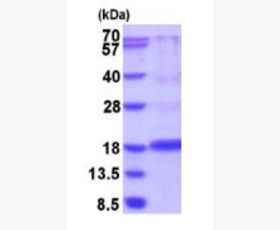Recombinant Human DNA Fragmentation Factor Subunit α/DFFA/DFF45/ICAD
| Product name: | Recombinant Human DNA Fragmentation Factor Subunit α/DFFA/DFF45/ICAD |
| Source: | E. coli |
| Purity: | Greater than 95% as determined by reducing SDS-PAGE. |
| Buffer Formulation: | Supplied as a 0.2 μm filtered solution of 20mM PB,150mM NaCl,pH7.4. |
| Applications: | Applications:SDS-PAGE; WB; ELISA; IP. |
| Storage: | Avoid repeated freeze/thaw cycles. Store at 2-8 oC for one month. Aliquot and store at -80 oC for 12 months. |
| UOM: | 100ug/50ug/200ug/1mg/1g |
| Source | E. coli |
| Description | Recombinant Human DFF45 is produced by our E.coli expression system and the target gene encoding Met1-Thr331 is expressed with a 6His tag at the N-terminus. |
| Names | DNA Fragmentation Factor Subunit Alpha, DNA Fragmentation Factor 45 kDa Subunit, DFF-45, Inhibitor of CAD, ICAD, DFFA, DFF1, DFF45, H13 |
| Accession # | O00273 |
| Formulation | Supplied as a 0.2 μm filtered solution of 20mM PB,150mM NaCl,pH7.4. |
| Shipping |
The product is shipped on dry ice/ice packs. |
| Storage |
Store at < -20°C, stable for 6 months after receipt. Please minimize freeze-thaw cycles. |
| Purity |
Greater than 95% as determined by reducing SDS-PAGE. |
| Endotoxin | Less than 0.1 ng/µg (1 IEU/µg) as determined by LAL test. |
| Amino Acid Sequence |
MGSSHHHHHHSSGLVPRGSHMEVTGDAGVPESGEIRTLKPCLLRRNYSREQHGVAASCLEDLRSK ACDILAIDKSLTPVTLVLAEDGTIVDDDDYFLCLPSNTKFVALASNEKWAYNNSDGGTAWISQES FDVDETDSGAGLKWKNVARQLKEDLSSIILLSEEDLQMLVDAPCSDLAQELRQSCATVQRLQHTL QQVLDQREEVRQSKQLLQLYLQALEKEGSLLSKQEESKAAFGEEVDAVDTGISRETSSDVALASH ILTALREKQAPELSLSSQDLELVTKEDPKALAVALNWDIKKTETVQEACEWELALRLQQTQSLHS LRSISASKASPPGDLQNPKRARQDPT
|
| Background | DNA Fragmentation Factor Subunit Alpha (DFFA). DFFA exists as a heterodimer (DFF) with DFFB. DFF is activated once DFFA is cleaved by Caspase-3. The cleaved fragments of DFFA detach from DFFB (the active component of DFF), which in turn triggers DNA fragmentation as well as chromatin condensation during apoptosis. A reduced level of DFFA detected in ovarian endometriosis may be a part of an apoptosis-resistant mechanism enhancing the disease progression. |














